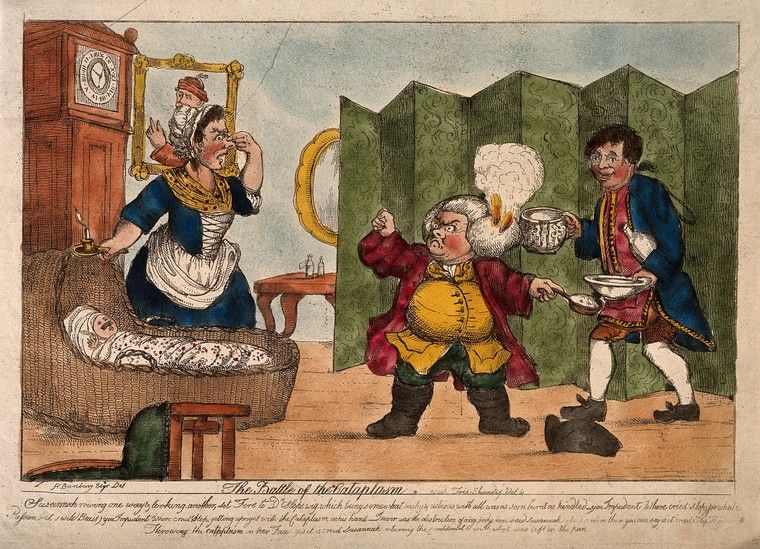Professional identity and the "revolution in obstetrics," i
Enter the man-midwife, stage left.

During the eighteenth-century, "man-midwife," and the more genteel title "accoucheur," became increasingly common designations for a new category of medical practitioner emerging in British society: men who practiced the traditional female craft of midwifery.
--Accoucheur, -if you please, quoth Dr. Slop. With all my heart, replied my father, I don't care what they call you . . . ---Laurence Sterne, Tristram Shandy
Whether they specialized in midwifery, or merely included it in the more general run of their practice, this new kind of medical men did not easily fit into the idealized, but longstanding, vision of the medical occupations as a three-part hierarchy:
- physicians: university-trained practitioners, whose theoretical knowledge of physiology is applied to internal medicine
- surgeons: apprenticeship-trained practitioners, focused on treating external ailments (burns, skin diseases), cutting (amputation, bloodletting) and other mechanical repairs (bonesetting)
- apothecaries: apprenticeship-trained practitioners, focused primarily on making and selling medicines, but often engaged in general practice
In theory, these three occupations were differentiated by their respective modes of training and approach to illness. In reality, these occupational distinctions were often ignored, although each group did have their own corporate body in London from the 16th century onwards.
Men who practiced midwifery faced open hostility from these professional organizations. Both the College of Physicians and the Company of Surgeons had by-laws excluding such practitioners from their governing bodies. Similar bodies in Edinburgh and Dublin had also resisted admitting men-midwives among their ranks.
This did not prevent the vast majority of medical men from dabbling in midwifery to one degree or another, particularly as the century wore on. By 1783 the College of Physicians had even grudgingly instituted a license in midwifery for its membership.
But the sense that they were not being taken seriously by their medical brethern rankled, especially among those men-midwives who rose to some degree of prominence. Feeling moved to publicly defend "the dignity of the profession," they even vigorously quarrelled with each other over the best manner in which to do so.
This infighting was such that by 1794, the London man-midwife Robert Bland dedicated the greater part of his Observations on Human and Comparative Parturition to condemning another a high profile practitioner for defending the man-midwifery so poorly.
The target of Bland's critique, William Osborn, does in fact begin his own 1792 Essays on the Practice of Midwifery announcing his aim to be "to rescue the art of midwifery from the charge of inutility."
But where Osborn chose to stress the inherent difficulty of childbirth as cause for professional assistance, Bland took a more subtle approach. Admitting that difficult cases occurred infrequently in what was a naturally easy process, he observed that nonetheless it was better to be safe than sorry:
"as there are no signs antecedent to labour, generally speaking by which they may be predicted, it seems prudent to employ, in the first instance, persons so educated, who being in the spot in time, may rectify what is amiss, and frequently avert a considerable share of the danger."
The effort taken to represent midwifery as a necessary and highly specialized area of professional medicine is striking, given that by the last quarter of the eighteenth century a substantial portion of the literate public agreed with them. Even more striking is the tortured prose of qualification--oh-so-polite dependent clauses piling up by the half dozen--that the aptly-named Bland used to press his case.
But what was at stake in the conflict between Osborn and Bland was the question of where the professional status of the man-midwife was located. Was he a skilled operator whose interventions could tame the life-threatening medical emergency that was childbirth? Or was he instead a genteel man of science, whose superior grasp of nature and her processes is what makes his oversight indispensible?
Strikingly, the one question that Bland and Osborn did not dedicate much energy to was the controversy that had animated the writings of most of their predecessors: the authority and legitimacy of men-midwives vis-avis the female midwives who had traditionally presided over childbirth.
